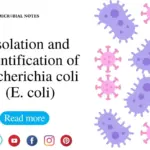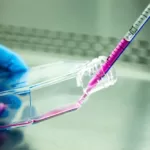Petri Dish History
The Petri plate also known as the Petri dish was invented in the nineteenth century by German bacteriologist Julius Richar Petri while working in Koch’s laboratory. Petri was an assistant to Robert Koch, a well-known German microbiologist. Bacteria were cultivated in test tubes or flasks with solid media at the time. As a result, it was tough to manage and observe.
Petri’s solution was to improve on the traditional method by developing a shallow, flat dish for easier observation and manipulation of bacterial colonies. He published his paper “Eine kleine Modifikation des Kochschen Platten Verfahrens” (A tiny modification of Koch’s plate method) in 1887, in which he explained the construction and applications of such a dish, which became known as a Petri dish.
Parts of Petri dishes
A petri dish is made up of critical components that help it work in the laboratory. The dish, which is usually a shallow, cylindrical jar with a cover, creates a controlled environment for microbial development. The lid protects against external contamination while allowing for required gas exchange. Furthermore, the flat bottom of the dish allows for regular distribution of culture material, which aids in constant microbial growth.
Types of Petri disshe
Based on shape
Petri dishes come in a variety of designs, each specific to meet the demands of certain experiments. The most frequent are circular dishes, which are used for general culture. Rectangular or square petri dishes are good for optimizing space since they may be put near together. Specialty forms, such as triangular or hexagonal dishes, are employed in unusual situations, such as crystallographic research.
Based on the Material
Petri dishes are made of a variety of materials, including glass and plastic. Because glass dishes are reusable, autoclavable, and exceedingly clear, they are ideal for microscopy experiments. Plastic petri dishes, on the other hand, are disposable, cost-effective, and lessen the danger of contamination, although they may not be as optically clear as glass.
Based on Compartments
Petri dish compartments provide a distinct benefit in research needing isolated settings. Multi-compartment petri dishes may hold several samples or experimental settings within the same dish, conserving space and resources.
Petri Dish Applications
- Petri dishes are widely used for culturing bacteria, fungi, and other microorganisms. They provide a controlled environment for the growth of these organisms, allowing researchers to study their characteristics and behaviors.
- Microbiologists use Petri dishes to isolate pure cultures of microorganisms from complex samples. By streaking or spreading the sample onto the agar surface, individual colonies can be obtained for further analysis.
- Petri dishes are essential for performing antibiotic sensitivity testing. Bacterial isolates are cultured on agar containing different antibiotics to determine their susceptibility, aiding in selecting appropriate treatments.
- Researchers can use Petri dishes to perform viable cell counts. Diluted samples are spread on agar, and after incubation, colonies are counted to estimate the original microbial population.
- Petri dishes are employed to assess microbial populations in various environments, such as soil, water, and air. This helps in monitoring changes in microbial communities and evaluating environmental quality.
- Microbiologists use Petri dishes to analyze food and beverage samples for the presence of pathogens and spoilage microorganisms. This aids in ensuring food safety and quality.
- Petri dishes play a role in clinical diagnostics, helping identify pathogens responsible for infections. Samples from patients are cultured on agar to isolate and identify the causative microorganisms.
- Researchers use Petri dishes to conduct experiments studying microbial growth, metabolism, and interactions. These studies provide insights into fundamental biological processes.
- Petri dishes are used in genetic engineering to grow genetically modified microorganisms. Selection markers on the agar allow scientists to identify successfully transformed cells.
- Petri dishes are utilized to investigate biofilm formation, a common mode of microbial growth. Researchers study how bacteria adhere to surfaces and form complex communities.
- In pharmaceutical research, Petri dishes are used to screen for potential antimicrobial compounds. Microorganisms are cultured on agar containing test compounds to assess their inhibitory effects.
- Petri dishes are essential tools in microbiology education. Students use them to learn basic techniques like streak plating, colony isolation, and microbial identification.
- Industries such as cosmetics, pharmaceuticals, and dairy use Petri dishes to perform quality control checks. Microbial contamination levels are monitored to ensure product safety.
- Petri dishes play a role in vaccine research by aiding in the cultivation of viruses and bacteria used in vaccine production.
- Microbiologists use Petri dishes to study microorganisms’ role in bioremediation processes, where they degrade pollutants and contaminants in the environment.
- Petri dishes are used to study microorganisms that promote plant growth, control plant pathogens, and contribute to soil fertility.
- Petri dishes are employed to assess water and wastewater quality by detecting the presence of indicator bacteria and pathogens.
- Researchers use Petri dishes to isolate and culture novel microorganisms for phylogenetic studies, contributing to our understanding of microbial diversity and evolution.
- Petri dishes are utilized to investigate disease mechanisms at the cellular and microbial level, providing insights into pathogenicity and host-microbe interactions.
- Microorganisms cultivated in Petri dishes can serve as a source of microbial biomass used in various applications, such as biogas production and biofuel development.
- Petri dishes are used to evaluate the effectiveness of disinfectants and sterilization techniques by observing their impact on microbial growth.
- Petri dishes are used in industrial settings to develop and optimize fermentation processes for the production of enzymes, antibiotics, and other microbial products.
- Microbiologists study microbial physiology using Petri dishes to investigate how microorganisms respond to different growth conditions, nutrients, and stresses.
- Petri dishes help researchers study aquatic microorganisms, including algae, bacteria, and protozoa, in freshwater and marine ecosystems.
- In forensic investigations, Petri dishes are used to culture and identify microorganisms associated with crime scenes, helping in solving cases.
The Benefits of Using a Petri Dish
The petri dish has various features that contribute to its lasting appeal. Its ease of use, low cost, and variety make it suitable for both seasoned researchers and students. The dish’s design makes it easier to observe microbial traits and interactions, which helps to develop microbiological understanding.
Petri Dish Limitations
Petri dishes, while helpful, have limits. They are limited to maintaining the growth of microorganisms that survive in flat, two-dimensional habitats, possibly rejecting more complicated species. Furthermore, contamination from airborne particles or incorrect handling could affect experimental results.
How Do You Use a Petri Dish in the Lab?
Using a petri dish involves a number of crucial processes. To begin, disinfect both the plate and the culture media separately to avoid contamination. Pour the medium into the dish and let it aside to solidify. The sample should then be introduced by streaking, spreading, or using a swab. In order to avoid condensation from dripping over the culture, incubate the dish upside down. Finally, watch and examine the microbial proliferation that results.
Why is the Petri Dish inverted during incubation?
During incubation, turn the petri dish upside down to avoid moisture from forming on the lid. This condensation can cause bacterial colonies to merge, making individual identification impossible. The upside-down position guarantees that any condensation on the lid’s upper surface does not interfere with the grown microorganisms.
Precautions
A number of measures improve the dependability of petri dish investigations. Maintain proper aseptic procedures while handling to reduce the risk of contamination. Seal the dishes properly to keep airborne pollutants out. Dispose of used dishes in a safe manner, following biohazardous waste disposal requirements. To achieve reliable findings, always operate in a controlled setting.

Examples of Petri Dishes
Numerous manufacturers offer a variety of petri dishes to meet a variety of needs:
MS-0350Z Petri dish (PHC Europe B.V./PHCbi): Known for its superior gas exchange capabilities, which facilitate homogeneous microbial growth.
CELL-D series petri dishes (Haier Biomedical): Designed for durability and ease, these dishes are suited for high-throughput investigations.
SterilinTM for Petri dishes (Thermo Scientific): These plates, made of clear polystyrene, are transparent and suitable with a variety of microscopy methods.
D210-17 (Simport) Petri dish with counting grid: Equipped with a counting grid, which simplifies colony enumeration and density calculations.
References
- https://archive.org/details/1887-petri-eine-kleine-modification-des-koch-schen-plattenverfahrens-2020-braus-
- https://microbiologie-clinique.com/petri-dish.html
- https://www.pharmaguideline.com/2015/09/incubation-of-petri-dishes-in-inverted-position.html
- https://www.medicalexpo.com/prod/phc-europe-bv-phcbi/product-70908-1008612.html
- https://www.medicalexpo.com/prod/haier-biomedical/product-299012-1058139.html
- https://www.medicalexpo.com/prod/thermo-scientific/product-78678-591283.html
- https://www.medicalexpo.com/prod/thermo-scientific/product-78678-591283.html
- https://www.medicalexpo.com/prod/simport-scientific/product-70088-1091010.html





